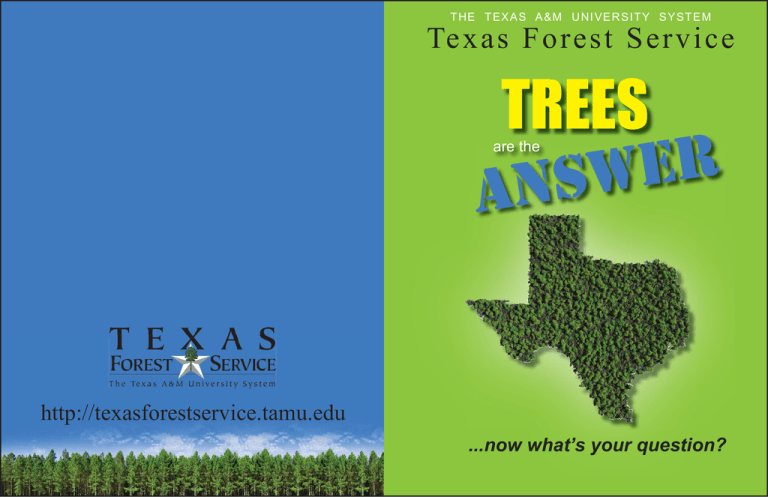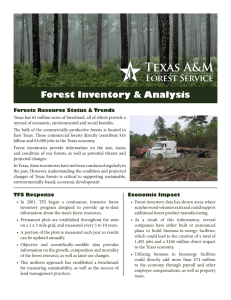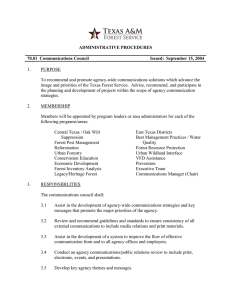TREES answer Te x a s F o r e...
advertisement

TH E TE X A S A & M U N IV E R S ITY SYSTEM Texas Forest Se r vic e TREES r e w s an are the http://texasforestservice.tamu.edu ...now what’s your question? Texas has 60 million acres of forestland - more than any other state in the lower 48 United States “Census for Trees” Texas Forest Service in cooperation with the Southern Research Station of the USDA Forest Service conducts a forest inventory to measure the status of forest resources in the state. The 1998 Farm Bill expanded Forest Inventory and Analysis activity in Texas from only commercial timberland (East Texas) to all woodlands. The newly implemented survey system measures 2,800 plots (10% of the state) per year. In January 2004, the first statewide inventory of trees began in the 211 Texas counties not part of the traditional timber producing area of East Texas. The state is so big that an entire inventory cycle takes 10 years and will be completed in 2014. Currently, almost 50% of the plots have been inventoried by Texas Forest Service FIA crews. Results of the inventory East Texas Outside of East Texas Forest type Juniper/Pine Mesquite Oaks Other Hardwoods Acres 9.3 million 17.0 million 8.0 million 13.8 million Tree Count: Juniper/Pine 3.5 billion Mesquite 5.5 billion Oaks 1.8 billion Other Hardwoods 3.4 billion % 19% 35% 17% 29% Forest type Pine Mixed Hardwood Acres 5.3 million 1.5 million 5.4 million Tree Count: Softwoods 2,2 billion Hardwoods 5.6 billion Volume: 17.6 billion cu. ft. of wood % 43% 13% 44% (Based on nearly 50% of plots, estimations of forest area, tree count and volume are now available. Values are expected to remain fairly consistent as remaining plot measurements are conducted.) Volume: 13.8 billion cu. ft. of wood Prior to this inventory, the area, volume and species composition of forestland outside of East Texas had never been sampled this intensively. Based on the USDA Forest Service definition of forestland, which is 10% crown cover or 200 seedlings per acre, it is estimated that the area of forestland outside of East Texas totals 48 million acres. Add to that number the 12 million East Texas acres and the state now has 60 million acres of forestland…more than any other state in the lower 48 United States. That’s also 23% of the forestland in the South. Comprehensive, science-based information FIA provides objective and scientifically-credible information and is part of the universal benchmark for measuring the sustainability and success of natural resource and land management practices. The results of this research will enable Texans to evaluate whether current timber management practices are sustainable and increase knowledge of state-wide issues such as fire fuel loading, tree regeneration rates, invasive species encroachment and overall forest health. FIA information is also useful in regional, state and local policy-making, planning, resource allocation and program management. New market possibilities “Keeping forests in forests” is one of the main goals of Texas Forest Service. According to recent trends, Texas landowners’ interest is shifting from agriculture production to wildlife and recreation. TFS consistently strives to serve landowners by acknowledging this interest and attracting and supporting new markets that possibly will generate income as well as retain contiguous land management despite differing landowner goals. The information provided by the inventory also positions Texas to engage in ecosystem services markets such as carbon and woody biomass for alternative energy. Woody biomass that can be used as a source of energy can now be quantified, helping identify potential alternative sources for energy. Opportunities for carbon sequestration can be better identified and quantified. Wildfire fuel loading As FIA data is collected and analyzed, the ability for Texas Forest Service to predict wildfire occurrences and intensities increases. Information acquired about amounts and types of vegetation combined with scientific weather data will aid the nationally-recognized Predictive Services component of the TFS Forest Resource Protection Program in predicting wildfire risk. about Sustainable Forestry Sustainable forestry allows for meeting the resource needs of the present without compromising the needs of the future. TFS provides focused, high priority innovation and expertise to its Sustainable Forestry Program through leadership in Forest Resource Analysis, Economic Development, Forest Inventory & Analysis, Global and International Forestry, Water Quality/Best Management Practices, Ecosystem Services, Wood Technology and Utilization, Geographic Information Systems, Forest Taxation, Forest Legacy, and Heritage Forests. Texas Forest Service Texas Forest Service is recognized as the leading state forestry agency in the nation through its programs in forest and tree development; wildfire prevention, mitigation and protection; urban and community forestry and assisting and training fire departments. Texas Forest Service was created in 1915 by the 34th Legislature as an integral part of The Texas A&M University System. Its mission is to provide statewide leadership to assure Texas’ trees, forests and related natural resources are protected and sustained for the benefit of all. The Southern Research Station Baseline for the future For the first time, Texas has a tool for detecting changes over time in the state’s forests and woodlands. Comparison of results from surveys over the years will track the rate of land clearing and invasiveness, growth, removals and mortality. The Southern Research Station is part of the Nation’s largest forestry research organization - USDA Forest Service Research and Development - the leading organization for research on natural resource management and sustainability in the United States. Headquartered in Asheville, North Carolina, the Southern Research Station serves 13 Southern States and beyond. Its staff of 130 scientists is organized into Research Work Units, with science technicians and other support personnel who work at various locations throughout the region: Federal laboratories, universities, and experimental forests.


